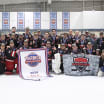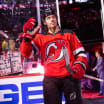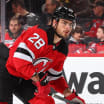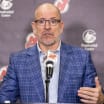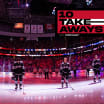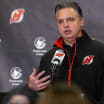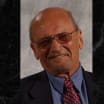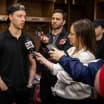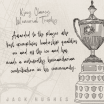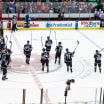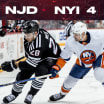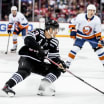This is a three-part series intended to shine a light on what happens behind closed doors as the New Jersey Devils prepare to make their selections at the 2018 NHL Draft in Dallas on June 22nd and 23rd. The first installment highlighted the importance of the player information department. This second installment details the player interview process at the NHL Scouting Combine.
Although there are still some playoff games happening in the Canadian Hockey League until the Memorial Cup is awarded in late May, the IIHF U18 World Championship in mid-April marks the unofficial end of the scouting season. Soon after the gold medals have been awarded, NHL teams gather their scouting staffs to debate and discuss the draft eligible prospects they've been watching all season as they put their list together for the upcoming NHL Draft.
Inside the Devils interview room at the NHL Combine
104 prospects were invited to Buffalo for the NHL Combine and the Devils met with more than half of them
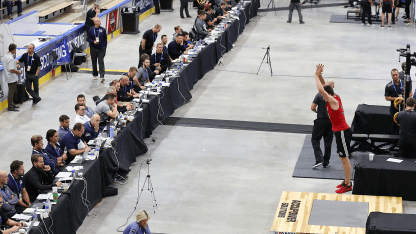
It's also when NHL Central Scouting - a team of scouts hired by the NHL to help provide independent information on the latest class of draft eligible prospects - releases their rankings for North American skaters, European skaters, and goaltenders. That list is distributed to all 31 NHL teams who are then asked which players they'd like to interview at the NHL Scouting Combine. If a player has enough teams interested in meeting with him, they are invited to the annual event held at Key Bank Center and HarborCenter in Buffalo the first weekend in June.
Most fans know of the combine because of the physical testing and the media availability that happens on the final two days, but during the week leading up to that televised portion, each prospect is put though a battery of medical tests and then runs the proverbial gauntlet of 15-minute interviews with various NHL teams.
The number of prospects invited varies from year to year, but usually lands between 100 and 120. This year, 104 prospects were invited to Buffalo and the New Jersey Devils met with more than half of them.
"Often times, we only get to see a player on the ice and you just want to see him off the ice to see if his personality matches what we thought and find out what motivates him to want to play at an elite level," said Devils director of amateur scouting Paul Castron. "We want to draft players that are going to fit the identity that Ray Shero] and John [Hynes] have asked for because if they don't fit the identity, they're not going to play and that doesn't do anyone any good. The more players that will fit into the culture they've created and will play to the identity that we want our players to have - fast, hard, competitive - the better off we'll be as an organization."
That said, this isn't a personality contest. They're not looking for the guy who tells the best jokes or presents himself exceptionally well and will be the next media darling.
"We don't need vocal guys, we just need guys who want to learn and get better and are good hockey players who want to become better hockey players and are willing to put in the work to get there," Castron continued. "We have to keep drafting guys like that. It's great to get guys with personality, certainly makes the locker room more fun, but it's not a requirement."
Dr. Aimee Kimball, director of player and team development, leads off the interviews at the combine and at the start of each one she asks the prospect to share something about themselves that most people don't know. Some give the basics like where they're from and how many brothers and sisters they have. Some share stories from their latest fishing or golfing experience. Some tell stories about family members or moments growing up that impacted them- on and off the ice. Some share funny stories about typical teenage pranks or they talk about the sports they used to play. And, some simply have no idea what to say and hesitantly ask for another question.
"These interviews show you their personalities but, at the end of the day, it doesn't matter if you're introverted or extroverted. Some guys come in and they're very shy or nervous, but that doesn't mean they're not going to be an excellent hockey player. It's the same for a guy that wows you because he has this awesome, outgoing personality, that doesn't mean he's going to develop into an elite hockey player either," Kimball explained. "In these interviews we're looking for intangibles and different qualities in their character that add value both on and off the ice. We find this through a combination of the stories they tell and the experiences they've had that demonstrate who they are as a person and as a teammate. We also want to see what they are made of and if they can handle the stress and pressure that will come through their career."
While Kimball discovers more about what makes each player tick, those in the room - Castron, assistant director of amateur scouting Gates Orlando, manager of player information and video Scott Harris, assistant manager of player information and video Kate Madigan, senior director of player personnel Dan MacKinnon, assistant general manager Tom Fitzgerald and general manager Ray Shero - taking notes,
[checking the Holy Grail
, reading scouting reports, occasionally watching video clips and skimming over media articles, but mostly listening.
"I do a lot of listening. If I've seen a player at a tournament or something, I might ask them a question or two, but I leave the heavy lifting to Aimee and Paul and Gates," MacKinnon said. "But, I'm always asking myself does this player have a good sense of who he is as a player and I always feel better if the answer is yes. Sometimes players, however talented they might be, have a very poor understanding of what their path to the NHL might be like. Not every sixth-round pick is going to be like Jesper Bratt and play in the NHL at 19 and not every first-round pick is going to be like Nico Hischier and play in the NHL next year and they have to be ok with that."
To help serve as a guide and to keep perspective in focus, those in the room are given a blank spreadsheet that is only for their use and acts more like a reference than a scoresheet. Each prospects name is written down the side and, along the top, there's columns for character traits the team is looking for or that the player exudes to them. In addition, there's a section for notes and maybe the only box that matters - Is this the type of guy I want on my team?
"These players have already been interviewed by our area scouts throughout the year, so these 15 minutes are an opportunity to follow up with things that we've found or need clarification on or maybe a situation with their coach, but really it's just a chance to get to know them and interact with them and see what they're all about," Shero explained. "You're not going to pick a guy because of his interview or not pick a guy because of his interview, it's just another piece of information that you can gather on all of these players that you could use in the draft in June or maybe in three years when you're looking to trade for a player or even six or eight years later when they become a free agent. It's just good to have that information."
So while the players are peppered with questions like what makes you a special player and what could prevent you from having the career you want, the only wrong answer is one that isn't honest because it's not about picking players that don't have any issues or concerns or red flags of any sort because that's human nature. It's about knowing what those concerns are in advance so you can best help that player improve fright from Day One.
"The questions we ask in these interviews all serve a purpose and all help me learn a little bit more about each prospect, so I can better understand how to help them reach their potential as a professional athlete," Kimball said. "The scouts already know what they can do on the ice, but it's my job to help the scouts look beyond a player's talent and help them understand the type of person they're getting with each prospect and how we can help him excel. I also identify any areas of concern we'd need to be aware of if we decide to draft a player because, whatever those concerns are, we know we have the support system in place to be able to help him reach his potential. On top of the information our scouts have already provided, the interviews help us to be more aware of what each player's strengths and weaknesses are before we draft him."
When each player leaves the room, the internal debate and discussion begins anew. Was he cocky or confident? Did he tell us what he really wanted to say or just what he thought we wanted to hear? Is he lazy or just laidback? Does he fit our criteria?
"Fifteen years ago, you drafted a player for what he did on the ice and then you started to learn more about him and maybe you didn't discover the issue for another six months or a year or maybe even two years later and you're scrambling to make up ground and that could be difficult," MacKinnon explained. "But then, you also didn't have the pressure of a salary cap on you and you could cover most of your drafting mistakes through free agency, but now, if you don't consistently draft well, you're going to pay a high price either through free agency or by not making the playoffs. It's really hard to recover from a streak of bad picks at the draft in today's NHL, which is why these interviews can be so important.
He continued: "We need to be prepared to help them be successful so they can help us win hockey games. We need to know everything we can about a player so we can help him learn and grow and develop and be a better hockey player and by extension help our team be better and make the playoffs and win Stanley Cups. That's really what it boils down to."
The final installment in this series will provide insight on what happens within the scouting department in the weeks between the combine and the draft as they prepare to hear the words, "New Jersey, you're on the clock."

